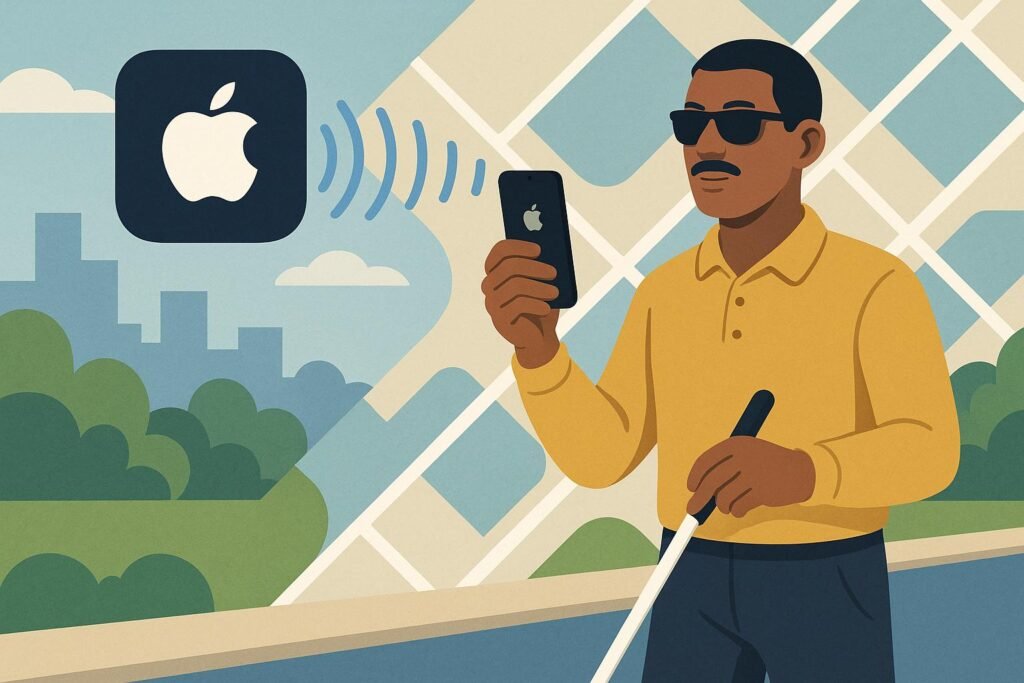

Apple AI Transforms Navigation for Blind
Apple AI Transforms Navigation for Blind is a powerful testament to how cutting-edge technology can redefine independence for visually impaired individuals. With a foundation built on artificial intelligence, Apple has developed a spatial navigation system that effectively eliminates many of the everyday challenges faced by blind and low vision pedestrians. By integrating visual imagery, GPS data, and secure anonymized datasets, Apple’s model delivers richly contextual street-level information such as intersections, sidewalks, signage, and traffic signals. This advancement not only demonstrates technological excellence but also marks a transformative step in accessibility innovation.
Key Takeaways
- Apple’s AI-based system enhances urban navigation for blind and visually impaired users by combining GPS data with street-level imagery.
- The technology significantly outperforms previous models in spatial awareness and multi-modal navigation tasks.
- Data privacy is a top priority in Apple’s AI development, reinforced by rigorous anonymization protocols and ethical compliance.
- This initiative aligns with Apple’s broader accessibility agenda and signals a shift in the future of assistive AI design.
Understanding Apple’s AI Navigation Breakthrough
Apple’s new AI model represents a major leap forward in accessible navigation. The system is designed to aid blind and visually impaired users in recognizing key street features, such as traffic lights, sidewalks, road crossings, and landmark proximity, through multi-modal inputs like satellite imagery, street-level photos, and GPS information. With this combined data, the AI creates a context-aware model of the user’s environment that can deliver real-time, accessible instructions.
This technology diverges from traditional turn-by-turn guidance systems. It contextualizes surroundings with spatial awareness and urban semantics, which is critical for non-visual travelers. The objective is not only to help navigate from point A to point B but to empower users with a comprehensive understanding of the path ahead.
How Apple AI Navigation for Blind Works
At its core, the Apple AI navigation for blind individuals uses a fusion of visual recognition and geolocation. The system is trained on vast datasets composed of anonymized imagery from urban areas. With machine learning techniques applied to cityscapes, the AI can detect key indicators such as curb cuts, stairs, pedestrian signals, stop signs, and building boundaries.
The AI processes this information to build a semantic map that supplements GPS with critical accessibility details. For instance, it can distinguish between a crosswalk with audio signals and one without. This produces real-time insights that guide users safely and efficiently. The system may be integrated within wearable devices or through the iOS ecosystem, expanding access across Apple platforms. For a deeper look at how Apple leverages AI in personal devices, explore how Siri is enhanced by artificial intelligence.
Comparative Accessibility: Apple vs. Microsoft vs. Google
| Feature | Apple AI Navigation | Microsoft Seeing AI | Google Lookout |
|---|---|---|---|
| Core Functionality | Street-level navigation with multi-modal spatial awareness | Object and scene description via camera | Item recognition, currency detection, text reading |
| AI Architecture | Visual-GPS semantic mapping | Object recognition and OCR | Image-to-text analysis with contextual cues |
| Navigation Support | Yes, with live street feature detection | No real-time navigation | Limited to object location |
| Integration | iOS + location-based services | Available on iOS and Android | Android only |
Real-World Use Scenarios and User Implications
Field testing of Apple’s AI model suggests an immediate value proposition for visually impaired users in urban centers. Potential scenarios include:
- Navigating complex intersections with inconsistent audible traffic signals
- Adjusting walking paths during construction or detours
- Identifying entrances to public buildings or businesses based on proximity
- Safely maneuvering through high-density areas such as transit stations or marketplaces
These advancements can complement existing solutions. One innovative example is the use of AI-powered smartglasses for the visually impaired, which offer hands-free assistance as users move through unfamiliar environments.
Beyond individual impact, the system presents opportunities for city-wide inclusivity. It could inform urban planning decisions with data-driven insights about pedestrian traffic and risk zones affecting the blind community.
Ethical Design and Data Privacy in Development
One of the hallmark elements of Apple’s engineering philosophy is its emphasis on privacy. True to form, the navigation AI adheres to strict guidelines for anonymization, use limitations, and ethical training protocols. All datasets are stripped of identifiable markers. User interaction data remains confined within the device or encrypted storage. No images are linked to individuals, specific addresses, or behavioral patterns.
This structure supports compliance with global AI ethics initiatives, including the EU’s AI Act and NIST’s risk management principles. To learn more about how Apple is advancing responsible AI, consider reading about Apple’s ethical AI framework.
The State of Accessible Navigation: 2023–2024 Statistics
- The World Health Organization reports over 253 million people worldwide experience moderate to severe vision impairment.
- In the United States, 7.6 million adults are estimated to have visual disabilities that affect mobility (National Federation of the Blind).
- More than 48 percent of blind adults regularly use assistive technology. Still, many areas lack adequate spatial data for safe navigation.
- Urban pedestrian accident rates remain significantly higher for blind individuals in cities without tailored accessibility infrastructure.
These data points highlight the importance of scalable tools like Apple’s navigation system, which must be designed with privacy and inclusivity as core principles.
“This kind of AI-powered spatial awareness could lead to universal design principles being embedded in both hardware and public infrastructure,” says Lina Rodriguez, a UX researcher focused on inclusive technology. “The great thing about Apple’s approach is that it doesn’t require users to learn completely new systems. It can plug into the tools they’re already comfortable with.”
Voice assistants and environment-aware devices may continue to evolve. Future versions could integrate with smart city infrastructure or adaptive mobility solutions, making the vision of a blind-accessible world more attainable. In related breakthroughs, companies have even experimented with the development of a robot designed to navigate without sight, showcasing how machines can be trained for mobility challenges faced by blind users.
Frequently Asked Questions
How is Apple using AI to help the blind?
Apple’s AI navigation system uses GPS and street-level imagery to understand and relay important real-world environmental cues. It provides visually impaired users with detailed interpretations of intersections, traffic lights, sidewalks, and more. This helps promote safer and more independent travel.
What accessibility tools does Apple offer?
Apple provides many accessibility features, including VoiceOver screen readers, haptic feedback, screen magnification, and real-time audio descriptions. The new AI navigation model enhances this ecosystem by offering real-world spatial guidance for blind users.
How do blind people currently navigate the streets?
Blind individuals typically use a combination of white canes, guide dogs, and mobility training. Apps like VoiceOver and Aira support navigation but often lack reliable environmental awareness in real time.
What are the challenges in pedestrian navigation for the visually impaired?
Barriers include unpredictable traffic signals, minimal tactile sidewalk guidance, unexpected construction with no alternative routes, and difficulties judging traffic based on sound alone. These risks limit full autonomy without advanced aids.
Conclusion
Apple’s innovation in AI-driven, street-level navigation represents a major turning point in inclusive mobility. By simplifying the way blind individuals interact with their environment, the technology offers more than convenience. It provides dignity and self-sufficiency. As Apple continues refining its AI technologies, new possibilities are emerging for equitable urban access. For a broader overview of how Apple is positioning itself in artificial intelligence, visit insights on machine learning, accessibility, and on-device intelligence at apple.com/research.
These developments highlight Apple’s commitment to integrating AI in ways that prioritize user privacy, contextual relevance, and universal design. The future of urban mobility will depend not just on smarter cities, but on smarter, more empathetic technology.




